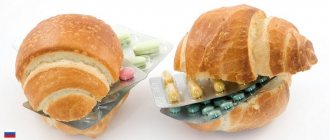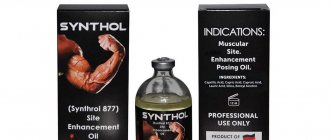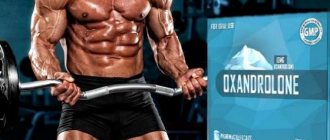Drugs for running
With the advent of drugs that can positively influence athletic performance, a lot of talk has been generated about the admissibility of this method. However, the mechanism was launched, and today it is experiencing the peak of popularity. In this regard, it was decided to create a document with a list of prohibited drugs. The document is regularly updated, and rarely any titles leave it.
Prohibited drugs
A list of prohibited drugs can be found on the WADA website, if you can sort through the many documents with recommendations and revelations. If you don’t want to look for information in an English-language source, then I bring to your attention a list of the main drugs prohibited for use for running and other sports.
Drugs containing erythropoietin are prohibited and are not recommended for use. Erythropoietin increases the hemoglobin content in the blood. Hemoglobin is a natural substance whose main task is to deliver oxygen to cells. Accordingly, the higher the hemoglobin level, the more oxygen the cells receive. There is an acceptable hemoglobin norm in sports: men - 160-180 hl, women - 130-150 hl. Exceeding this limit, even without using prohibited substances, will result in disqualification.
Anabolic drugs (agents) or steroids are also included in the doping list. The use of substances that increase the anabolic effect will inevitably lead to the disqualification of the athlete. Examples include: oxandrolone, stanozolol, turinabol. There are also non-steroidal anabolic substances that are not on the prohibited list.
Narcotics are also included in the list of prohibited drugs. The use of narcotic substances dulls the feeling of pain and fatigue, and helps relieve physical and psychological stress. Known drugs include:
- Cocaine
- Caffeine (more than 12 mcg/ml)
- Methylamphetamine
Corticosteroids are semi-illicit substances. Approved for superficial local use. Prohibited compounds include: beclomethasone, dexamethasone, triamcinolone, cortisone, methylprednisolone, sinaflan and other similar compounds.
When choosing corticosteroids, pay attention to whether they contain prohibited types of compounds.
There are also prohibited methods that are classified as doping:
- Expansion of oxygen carriers: the use of blood cells that differ from the standard set, the use of unusual methods of treatment, the use of substances that increase the hemoglobin content (erythropoietin).
- Masking methods that allow, through manipulation, to partially or completely hide the fact of doping.
- Gene doping, which has been used recently, is a prohibited method. Doctors manage to influence an athlete’s performance by manipulating genes, compressing or expanding them.
Approved drugs
The list of drugs approved for use is quite large, despite the ban on many substances. Let's focus on drugs that are directly related to doping in running.
Riboxin is a non-steroidal anabolic agent. Runners use it to support the heart, it is a distant analogue of mildronate. A relatively inexpensive drug with no residual effect. Foreign athletes often use a more expensive analogue - inosine.
Heptral is a drug for the liver. After a running workout, slight cirrhosis of the liver occurs, and Heptral helps eliminate the consequences. The drug is quite expensive, but has no residual effect.
Ferroplex - used for regular intense training, 2 times a day after meals (no more than 6 tablets per day).
Phytin – accelerates recovery processes, must be consumed for several weeks. Used before competitions.
Cernilton - used in case of frequent flights. Allows you to adapt to constant changes in time zones.
Vitamins, such as fermaton, are also allowed for use in acceptable dosages. Used to replenish the balance of lost vitamins during training.
If you know substances that are approved for use and will be useful for a runner, write the name and the drug will certainly add to this information. Personally known running doping has been described.
Top 7 Supplements to Improve Endurance
If you prefer long morning runs or regular trips to the pool instead of traditional strength training, it's important to know that there are the right supplements that can help you take your training and performance to the next level. In this article, we bring you a list of the 7 best sports supplements for endurance athletes!
Endurance athletes typically engage in regular, sustained physical activity, whether it's running 80 to 100 kilometers a week, cycling more than 300 kilometers a week on a road bike, or swimming hundreds of laps in a pool. This huge volume of work, supplemented with a couple of strength training sessions throughout the week, means that endurance athletes must pay extremely close attention to their diet and supplement stack.
Endurance training places high demands on the athletes' bodies from a physical, mental and energetic point of view. Plus, in addition to spending a lot of time doing the endurance training itself, you'll also need to spend a lot of time preparing and consuming nutritious foods for optimal energy replenishment.
Luckily, with the right supplement stack, you can save some time on cooking, increase productivity, improve recovery, and set yourself up to set new personal bests. Below is a list of the top 7 supplements that are recommended for endurance athletes!
1. Creatine monohydrate
Creatine supplementation is generally not often cited for its positive effects on endurance training. In general, creatine consumption is associated with improved strength, speed and power - and for good reason. Hundreds of published scientific studies support the use of creatine as an effective ergogenic aid for increasing strength and muscle size. But while many athletes believe that creatine has no place in an endurance athlete's supplement stack, we still argue otherwise.
Primarily, creatine provides an increase in phosphocreatine reserves, a rapid increase in ATP production, and an improvement in anaerobic performance. However, beyond its direct effects, creatine offers a host of indirect benefits for runners, cyclists and triathletes and helps take their training to the next level.
Creatine supplementation has been shown to reduce recovery time over repeated intervals as well as increase power output at anaerobic threshold. Improvements in speed and power and more efficient energy expenditure during training lead to higher performance over the long term.
Recommended dose: 3-5 g per day. It is recommended that you skip the traditional loading phase when consuming creatine, as the initial increase in body weight caused by increased body water reserves can slow down the speed of your workouts.
2. Caffeine
Caffeine has long been used to enhance performance by endurance athletes. In addition to providing a quick boost of energy for early morning workouts, caffeine's ability to reduce the perception of effort and curb the onset of fatigue makes it easier to cope with prolonged exercise.
There is a ton of research on the benefits of caffeine consumption for endurance performance, including improved performance in cycling, skiing and 5K running, as well as improved timing. As an added bonus, caffeine helps increase fat oxidation, which can help fight excess weight.
Because caffeine reaches its highest concentration in the blood about an hour after consumption, it is recommended to take it 60 minutes before exercise. Although caffeine is a diuretic, meaning it increases urine production, a recent review article by researchers at the University of Connecticut suggested that caffeine consumption does not cause fluid imbalance or decreased tolerance to increased body temperature during exercise.
Recommended dose: 2.5-5.5 mg per kilogram of body weight (200-400 milligrams for an 80-pound person) 60 minutes before exercise.
3. Beta-alanine
Everyone knows that beta-alanine is guaranteed to improve performance and inhibit the onset of fatigue during high-intensity physical activity, but is this true for endurance athletes? In fact, just because you're doing endurance training doesn't mean you're doing only low-intensity exercise, right?
Speed, tempo, and even low-start lifting technique are all aspects of training that are improved by consuming beta-alanine. In fact, some studies have demonstrated the positive effects of beta-alanine supplementation on performance and endurance, particularly cycling performance and rowing performance.
During high-intensity training, hydrogen ions accumulate in the body. An increase in their concentration helps to lower the pH level, which ultimately leads to a faster onset of fatigue. As an amino acid derivative, beta-alanine has been shown to help increase intramuscular carnosine content, which improves the body's ability to buffer hydrogen ions. This has the potential to inhibit the onset of fatigue and have the potential to improve physical performance, increase training volume, and reduce the perception of fatigue.
Recommended dose: 3-6 g per day, taken in 800 mg doses throughout the day to reduce the risk of developing paresthesia
4. Sodium phosphate
Although sodium phosphate is primarily used as a preservative for meat and other foods, surprisingly, it also helps increase physical performance. Consumption of sodium phosphate has been shown to improve aerobic capacity and increase time to fatigue by improving the ability of red blood cells to deliver oxygen to active muscles. In addition, some studies have demonstrated improvements in physical endurance through increases in maximum oxygen consumption and ventilatory threshold.
Recommended dose : 3-5 g per day, taken in 1 g doses for 3-6 days before competition or serious endurance training.
5. Branched chain amino acids (BCAAs)
If you're going on a strenuous run or a long bike ride, don't forget to grab a jar of BCAAs. The occurrence of fatigue as a result of strenuous physical activity is due to the mechanism by which free molecules of the amino acid tryptophan cross the blood-brain barrier (BBB) and enter the brain. Another downside of tryptophan is that it promotes the release of certain neurotransmitters—particularly serotonin—which can cause decreased arousal, increased sleepiness, decreased mood, and ultimately, faster onset of fatigue.
Because BCAAs and tryptophan compete for the same carrier protein, increasing BCAA concentrations can reduce the amount of tryptophan crossing the BBB, potentially inhibiting the onset of fatigue. Moreover, BCAA metabolism has been shown to reduce lactic acid production, potentially leading to improved endurance performance.
Available scientific evidence also suggests that BCAAs reduce protein breakdown in skeletal muscle and promote effective recovery and a positive immune response to exercise.
Recommended dose: 3-6 g before or during exercise. The optimal ratio is 2:1:1 leucine to isoleucine and valine.
6. Protein
It doesn't matter if you're gluten-free, low-carb, fat-free, paleo, or any other nutrition trend—you need protein. Although endurance athletes often focus more on adequate carbohydrate intake, protein is still essential for building, repairing and maintaining muscle mass.
Additionally, when you exercise for long periods of time, the body begins to use protein as an additional source of energy. Adequate protein intake becomes even more important in this case, because otherwise you will have to sacrifice muscle tissue protein!
If you want to get the most out of consuming protein supplements, it is recommended to take them with carbohydrates, as the combination of macronutrients leads to improved rates of protein and glycogen synthesis.
Recommended dose: 1-1.5 g per kilogram of body weight per day. During periods of high volume or high intensity training, it is recommended to increase protein intake to 2 g per kilogram of body weight for more effective recovery and maintenance of muscle mass.
7. Glutamine
Glutamine is the most abundant amino acid in our body, so why is it necessary to take it as a supplement? In fact, during intense physical activity, glutamine stores are used up faster than the body can replenish them, which unfortunately forces the body to break down its own muscles, causing a destructive catabolic state. Low glutamine levels can also compromise your immune system, increasing your risk of developing various infections.
Consuming glutamine supplements has been shown to improve recovery and strengthen immune function after endurance training. A study published in the European Journal of Applied and Occupational Physiology, which included more than 200 runners and rowers, found that 81% of athletes taking glutamine supplements reported no infectious diseases after intense training. For comparison, in the group taking placebo substances, only 49% of subjects indicated this. This study suggests that glutamine may help reduce the risk of developing infectious diseases after prolonged exercise, leading to improved performance and faster recovery.
Recommended dose : 20 g per day
Application of ZMA
ZMA (zinc monomethionine aspartate) – has widespread use in running. Composed of zinc, magnesium and vitamin B6 - hence the name. The main effects resulting from consumption are increased endurance and accelerated growth of muscle mass. Available primarily in 160 mg capsules. Must be taken 3 times a day.
It is forbidden to take by pregnant or lactating women, as well as simultaneously with medications. An overdose leads to nausea and vomiting, and also has a detrimental effect on the heart due to the high concentration of magnesium (150 mg).
Calcium
Bone protection is one of the priority tasks of every runner, due to the enormous loads on the musculoskeletal system during running.
This is especially true for asphalt and other hard surfaces. In addition, calcium provides benefits to runners in the form of heart protection, blood pressure control, and proper movement of nutrients across cell membranes. CalciumSee all calcium
NaturalSupp
NaturalSupp Bone Formula 60 caps 576 rub. Servings: 30 Price per serving: 19.20 rub.
Buy
Maxler
Maxler Calcium Citrate Plus D3 120 tablets 663 rub. Servings: 60 Price per serving: 11.05 rub.
Buy
Universal Nutrition
Universal Nutrition Calcium Zinc Magnesium 100 tablets 892 rub. Servings: 33 Price per serving: 27.03 rub.
BioTech USA
BioTech USA Calcium Zinc Magnesium 100 tabs 499 rub. Servings: 33 Price per serving: 15.12 rub.
L-carnitine
L-carnitine has a second form, D-carnitine - they are similar and almost completely repeat each other’s structure. Carnitine is recommended for use by athletes actively involved in cyclic sports, in particular running. Levocarnitine accelerates metabolic processes, promotes weight loss and muscle growth as a result of active physical activity.
Often used in diets, it remains underappreciated because consuming any form of carnitine without cardio will not provide any beneficial effects. When combined with diet and running, it brings quick, positive results.
KLA
Conjugated linoleic acid is a healthy fatty acid and is valued for its ability to increase metabolic rate, thereby allowing the body to burn more calories and therefore lose weight.
If you run with the goal of staying in shape and being slim, then the KLA will help you get closer to this goal with greater efficiency while expending the same amount of effort. In addition, CLA helps lower cholesterol levels and strengthen the body's immune defense. CLA, KLASee all CLA, KLA
Optimum Nutrition
Optimum Nutrition CLA 90 caps RUB 1,215 Servings: 90 Price per serving: 13.50 rub.
Buy
Nutrex
Nutrex Lipo-6 CLA 180 caps RUB 1,396 Servings: 180 Price per serving: 7.76 rub.
Buy
VP laboratory
VP laboratory CLA 1000 180 caps 1,540 rub. Servings: 180 Price per serving: 8.56 rub.
Buy
Geneticlab
Geneticlab CLA 60 caps 599 rub. Servings: 60 Price per serving: 9.98 rub.
Buy
Does an amateur need doping?
Newcomers and amateurs often wonder about the advisability of using doping in order to speed up the process of achieving results. Indeed, does doping for a non-professional make any practical sense? When it comes to running, doping is not recommended.
It will be enough to choose your diet and running training program for yourself. These two components will speed up the achievement of results without resorting to doping. If the goal of jogging is to lose excess weight, then you can use levokartinin in reduced dosages.
The result will begin to improve with at least 3 runs per week lasting about 1 hour. Training should occur every week for several months. The first two weeks will be accompanied by rapid growth in results, so it will be useful and interesting to monitor your progress. In the future, setting a personal best will be more difficult, which will require a different approach to training.
It is worth remembering that the advisability of using doping for running exists in the case of a “ceiling”, when the result stops improving. It is in this case that professional athletes begin to use drugs. However, cases of doping by young athletes are not uncommon.
Caffeine, guarana
Increased energy, increased concentration, attention and motivation are provided by the natural energy drink caffeine.
Undeniable benefits for running. If you find yourself in situations where you have to force yourself to go for a run, a caffeine boost will get you in the right frame of mind. In addition, caffeine is known as a fat burner due to its ability to speed up metabolism, increasing the body's calorie intake. Guarana is a natural source of caffeine with a sustained release of this alkaloid. CaffeineSee all caffeine
Optimum Nutrition
Optimum Nutrition Essential Amino Energy 270 g RUB 1,294 Servings: 30 Price per serving: 43.13 rub.
Choose a flavor
25th hour
25th hour Energy Drink TABS 15 tablets 418 rub. Servings: 15 Price per serving: 27.87 rub.
Choose a flavor
QNT
QNT EnerGel 55 ml 110 rub. Servings: 1 Price per serving: 110.00 rub.
Choose a flavor
Optimum Nutrition
Optimum Nutrition Essential Amino Energy Tea Series 270 g RUB 1,294 Servings: 30 Price per serving: 43.13 rub.
Choose a flavor
GuaranaSee all guarana
Maxler
Maxler Energy Storm Guarana 2000 Shots 20×25 ml RUB 1,192 Servings: 20 Price per serving: 59.60 rub.
Choose a flavor
FIT-Rx
FIT-Rx Guarana 2000 Vitalife Lin 20×25 ml 896 rub. Servings: 20 Price per serving: 44.80 rub.
Choose a flavor
QNT
QNT EnerGel 55 ml 110 rub. Servings: 1 Price per serving: 110.00 rub.
Choose a flavor
4Me Nutrition
4Me Nutrition Guarana 2500 1000 ml RUB 1,290 Servings: 40 Price per serving: 32.25 rub.
Choose a flavor
What to choose: doping or energy drink for running?
The significant difference between doping and energy drinks is duration and residual power. After a one-time use of doping, the result is unlikely to improve, and energy drinks last up to 24 hours when taken once. However, professional athletes prefer the first option.
Regular use of doping allows you to strengthen the result and achieve it every time. In addition, such drugs permanently change the composition of the blood, which affects the development of muscles that continuously consume substances from the blood. With constant use, it causes a permanent long-term effect, which disappears several years after stopping use.
Energy drinks allow you to instantly improve results for a shorter time. Moreover, a day after taking the energy drink, the result will be the same as it was before taking it. And yet, athletes consume energy drinks before training or starting a marathon. Energy drinks are allowed for consumption, but their dosage is strictly regulated.
Another difference between the two improvement options is the difficulty of detection. Detecting energy drinks is quite simple and does not take much time, since it is expressed in a sharp increase in the content of a spectrum of substances in the blood. Finding doping in a sample is a longer process, and in rare cases the sample is considered negative, although the athlete has used a prohibited drug.
Energy gels - recharge
On a long distance you will definitely need energy boost and the best source of fuel here is undoubtedly energy gels.
Ease of use, portioned packaging, various variations of tastes and textures, and most importantly a quick source of nutrients to maintain the body’s performance. The composition of the gels may differ depending on the manufacturer, but the basis is approximately the same: fast carbohydrates, sodium, potassium and other minerals. Some products may additionally contain caffeine, carnitine and other energy supplements. Energy gelsSee all energy gels
SiS
SiS GO Isotonic Energy Gel 60 ml 103 rub. Servings: 1 Serving price: 103.00 rub.
Choose a flavor
VP laboratory
VP laboratory Energy Gel Vplab 41 g 100 rub. Servings: 1 Price per serving: 100.00 rub.
Choose a flavor
QNT
QNT EnerGel 55 ml 110 rub. Servings: 1 Price per serving: 110.00 rub.
Choose a flavor
SiS
SiS GO Energy + Electrolyte Gel 60 ml 152 rub. Servings: 1 Price per serving: 152.00 rub.
Choose a flavor
What is the residual effect in a doping sample?
Residual effect is the remainder of the prohibited substance in the sample (blood or urine) that remains after consuming the drug. Different substances have different periods of complete elimination from the body. For example, various forms of nandrolone are eliminated from the body within 1-2.5 years. That is, during this time the effect of steroids continues.
There is a group of drugs that do not leave a residual effect due to rapid elimination. Among them you can find permitted and prohibited substances. The list of permitted substances includes Riboxin, a drug for the heart. As a result of administration, there is a slight anabolic effect and is considered a non-steroidal substance.
The use of drugs to enhance physical performance is a personal matter for everyone, but before taking it, you should weigh all the pros and cons, assess the risks and consequences. Much can be achieved without the use of anabolic or narcotic substances. Proof of this is the many world records that were set even before the advent of the pharmacological era in sports.
If you find an error, please select a piece of text and press Ctrl+Enter.
Side effects for men and women
Representatives of the stronger sex may exhibit the following specific reactions:
- breast and mammary gland enlargement;
- impotence;
- decrease in testicle size;
- deterioration in sperm production.
Women may notice side effects such as:
- deepening of the voice;
- clitoral enlargement;
- cessation of breast development processes;
- irregularities in the menstrual cycle;
- active hair growth on the stomach, face and back.
There are also consequences that apply to both men and women. These include:
- acne or a large number of small pimples all over the body;
- baldness;
- increased risk of tendon rupture, because the ligaments are simply unable to quickly strengthen muscle mass (often observed after stopping taking the drug);
- disturbances in liver function, as well as the development of cancerous tumors;
- reduction of “correct” cholesterol;
- aggressive behavior;
- fairly high blood pressure;
- mental disorders, often leading to deep depression;
- drug addiction;
- diseases of the cardiovascular system;
- increased aggressiveness, which entails abnormal sexual and even criminal behavior;
- development of infections and diseases such as HIV, hepatitis;
- increase in “bad” cholesterol in the blood (lipoproteins with a fairly low density).











